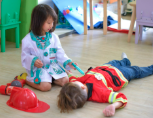Asking for help is a powerful skill that supports learning, resilience, and emotional well-being. For young children, learning how and when to ask for assistance is just as important as learning letters or numbers. By encouraging this skill early, caregivers and educators can empower children to become confident, self-aware, and better prepared to face challenges with a healthy mindset.
Why This Skill Matters
Children who feel comfortable seeking help are more likely to stay engaged in learning and less likely to become overwhelmed. Instead of shutting down in the face of difficulty, they learn to view challenges as opportunities for connection and growth. This not only builds academic strength but also emotional resilience.
Creating a Supportive Environment
Children must first feel safe and respected in order to ask for help. Adults can foster this by:
-
Using warm and open body language when a child seeks assistance
-
Offering gentle encouragement when a child hesitates
-
Celebrating efforts and praising questions, not just correct answers
When adults model these behaviors, children quickly understand that seeking support is a normal and encouraged part of the learning process.
Practical Ways to Teach the Skill
1. Role-Play Common Scenarios
Use simple role-playing to show how to ask for help. For example, act out a situation where a child can’t open a glue bottle and then ask, “Can you help me, please?” Let children take turns practicing.
2. Use Picture Books and Stories
Books featuring characters who ask for help can spark discussion. Ask open-ended questions like, “What would you do if you were in this situation?”
3. Provide Helpful Language
Teach children phrases such as:
-
“I don’t understand. Can you show me?”
-
“Can I try again with a little help?”
-
“I need help with this part.”
4. Reinforce Through Routine
Make it part of the daily rhythm—during play, snack time, or clean-up. For example, “If you need help carrying your tray, you can ask me or a friend.”
5. Acknowledge Efforts
When a child asks for help, respond with appreciation: “I’m glad you asked—that was a smart choice.” This builds confidence and reinforces positive behavior.
Helping Children Recognize When to Ask
Some children hesitate because they worry about being judged or think they should already know the answer. To ease these concerns:
-
Remind them that everyone needs help sometimes, even adults
-
Encourage them to try first, but to recognize when it’s okay to seek support
-
Normalize the process in group settings so that all children see it as a shared part of learning
Conclusion
Teaching children how to ask for help nurtures more than problem-solving—it fosters trust, emotional security, and independence. By embedding this skill into daily life, educators and caregivers can build a community where learning is collaborative and supportive. With the right encouragement, children will carry this valuable skill into every stage of life.


